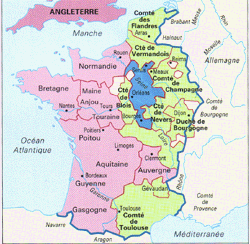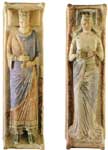
Map of France ca. 1180, showing relative territories of the ![]() Plantagenets, the
Plantagenets, the ![]() King of France, and
King of France, and ![]() other French Vassals. Larger Map
other French Vassals. Larger Map

|
Map of France ca. 1180, showing relative territories of the |
Plantagenets.
The name Plantagenet originated with Geoffrey because he sported a sprig of yellow broom plant (plante de genet o Planta genistrae) in his hat so that his followers could recognize him in his mail. The Angevin Plantagenets came to control a great deal of territory in the twelfth century, perhaps enough to justify the term "empire". They were significant patrons of art and architecture in western France. Domed Romanesque churches (in Fontevraud and Aquitaine, for example) reflected models known to the Crusaders. Supreme examples of "Plantagenet Gothic" are seen in Angers, Le Mans and Poitiers.
Geoffroi d'Anjou or Geoffroi le Bel (24 August 1113 - 7 September 1151)
In 1129, he married Mathilda of Normandy (d. 1167, granddaughter of William the Conqueror and widow of the German emperor.) After the death of the King of England, he was involved in the chaotic struggle for the succession, successful in that he was able to rule Normandy, and his son Henry became king of England after the death of Stephen in 1154. Count of Anjou in 1130; Duke of Normandy in 1144. His tomb is in LeMans, capital of the neighboring comté of Maine.

|
Gisants of Henry II and Eleanor of Aquitaine |
Henry II (1131, in LeMans - 1189, in Chinon)
From his father Geoffroi Henry inherited Maine, Anjou and Normandy. In 1154 was crowned King of England. His marriage in 1152 to Eleanor of Aquitaine (Alie'nor d'Aquitaine) brought the area of Aquitaine, Poitou and Provence into Plantagenet hegemony. Henry was constantly on the battlefield, but considered Chinon his main residence, especially at the end of his life. His legacy in England was administrative, but his reign is remembered as controversial. Eleanor left her first husband King Louis of France to marry the dashing young Henry. Their sons battled each other and their father as well as other nobles for the succession to the Plantagenet empire. Henry's great friend Thomas Beckett became his adversary when appointed Archbishop of Canterbury in ___. Their struggle over the respective rights of church and state resulted in the murder (29 December 1170) of Beckett in the cathedral and the subsequent establishment of his popular cult in Europe. Henry is buried at Fontevraud.
Eleanor of Aquitaine or Aliénor of Aquitaine (1122 - April 1 1204, in Fontevraud
Allowed to inherit from her father Guillaume X, at his death in 1137, Eleanor received control of of the duchy of Aquitaine and the Comté of Poitiers. That same year, she married Louis VII King of France, bringing her territories under control of the French crown. Boldly she accompanied her pious husband on the Second Crusade in 1147, riding forth bare-breasted like an Amazon warrior queen. The two were not particularly suited, however, and their children were all daughters. In 1152, Eleanor divorced and remarried Henry II of Anjou. After his death in 1189, she became Abbess of the convent of Fontevraud, where she lived until her death. Eleanor kept a brilliant court, and is known for her patronage of the arts, particularly the poetry of the occitan troubadours like Bernart de Ventadour and the romances dealing with the Arthurian matière de Bretagne, particularly those of Chrétien de Troyes.
| It is speculated that a verse from the Carmina Burana refers to Eleanor of Aquitaine, 10. Were diu werlt alle min | ||
| Were diu werlt alle min von deme mere unze an den Rin des wolt ih mih darben, daz diu chunegin von Engellant lege an minen armen. |
Were all the world mine from the sea to the Rhine, I would starve myself of it so that the queen of England might lie in my arms. |
si tout le monde était mien de la mer jusqu'au Rhin, Je m'en priverais pour que la reine d'Angleterre 'allongeât dans mes bras |
This page was meant to be viewed in frames. |
 Return to Return toAmelia Carr's Home Page |